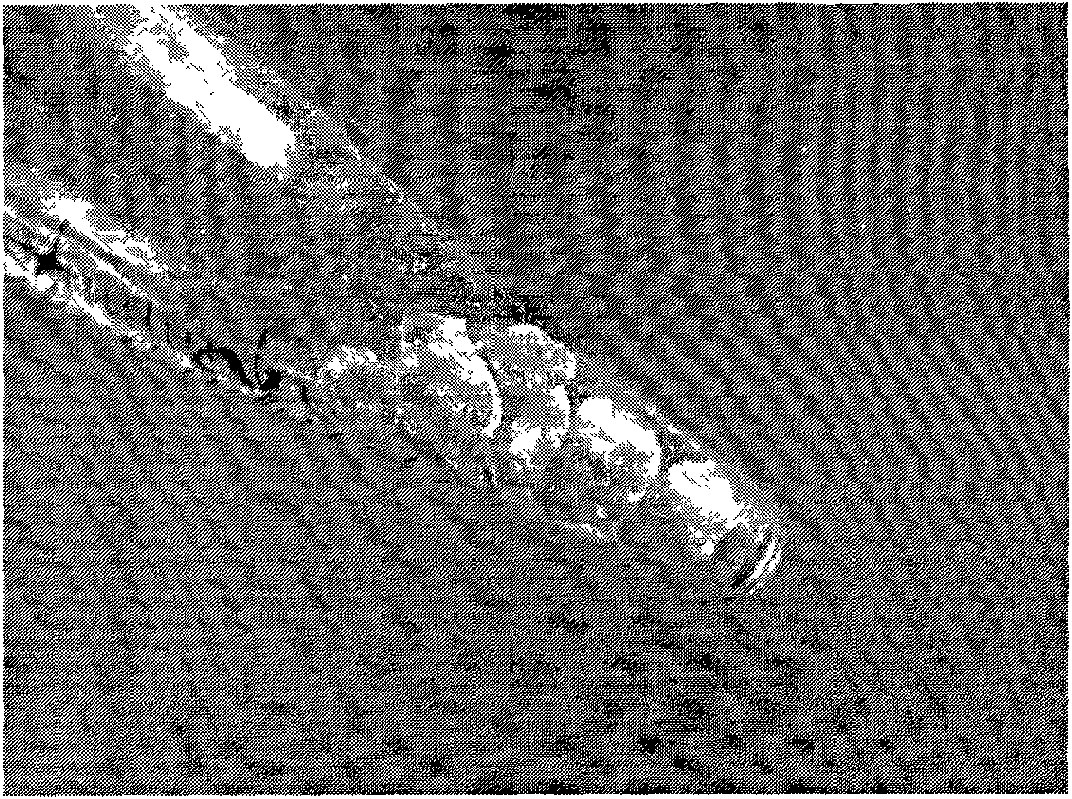Injectable myocardial tissue engineering product applying OPF-based hydrogel as liquid scaffold
A tissue engineering and hydrogel technology, applied in the field of injectable myocardial tissue engineering products, can solve the problems that have not yet been reported, and achieve the effects of facilitating treatment operations, promoting myocardial tissue regeneration, and simple operation technology.
- Summary
- Abstract
- Description
- Claims
- Application Information
AI Technical Summary
Problems solved by technology
Method used
Image
Examples
Embodiment 1
[0031] Embodiment 1: the preparation of OPF
[0032] Dissolve 30 g of polyethylene glycol with a molecular weight of 1000 in 250 ml of toluene, and after azeotropic distillation, dissolve the dry polyethylene glycol in 250 ml of anhydrous dichloromethane. Fumaryl chloride (0.3 mol) and triethylamine were then added dropwise to the polyethylene glycol solution over 5 hours while the reaction flask was maintained at 0°C and stirred at room temperature for 1-2 days to ensure maximum conversion. After the reaction, the solvent was removed by rotary evaporation, after which the product was dissolved in 500 ml ethyl acetate. The solution was filtered to remove the salt formed by chloride ions and triethylamine during the reaction, and the oligomer was recrystallized twice in ethyl acetate. Finally, pure OPF was precipitated in diethyl ether and dried in vacuo (figure 1 ).
[0033] Purified OPF was stored at -20°C and sterilized before use by exposure to ethylene oxide for 16 hours...
Embodiment 2
[0034] Embodiment 2: Histocompatibility detection of OPF hydrogel
[0035] 0.1ml of OPF hydrogel was injected and implanted into the myocardium of S-D rats, and they were sacrificed at 1, 2, and 4 weeks respectively. Two rats were taken each time. After the specimens were taken out, paraffin sections were made for HE staining to observe the inflammatory reaction. One week after surgery, the OPF hydrogel was widely distributed in the myocardial tissue space, and a little inflammatory cells were mixed in between ( figure 2A); 2 weeks after operation, the OPF hydrogel was partially degraded and surrounded by inflammatory cell infiltration ( figure 2 B); No obvious OPF hydrogel can be seen in the 4-week group after operation, and a small amount of inflammatory cell infiltration can be seen ( figure 2 C).
Embodiment 3
[0036] Embodiment 3 Preparation of cardiomyocytes derived from mouse embryonic stem cells (mES)
[0037] Preparation of mouse embryonic fibroblast feeder layer: kill BALB / C mice at 13-15 days pregnant, remove the head and internal organs of the embryos under aseptic conditions, wash them thoroughly with PBS, cut them into pieces and suspend them in Digest in stages in 0.25% trypsin solution. Stop the digestion at an appropriate time, aspirate the supernatant and centrifuge to collect the cells. Cell viability was identified by the trypan blue exclusion method, and counted at 5×10 8 cells / L were resuspended in H-DMEM medium containing 10% FBS, 37°C, 5% CO 2 and cultured overnight in a saturated humidity incubator. The next day, the cells were frozen for later use or directly prepared as feeder cells: MEFs were treated with a medium containing 10 mg / L mitomycin C for 2.5-3 hours, and washed sufficiently with PBS to remove residual components. Adding H-DMEM medium containing ...
PUM
 Login to View More
Login to View More Abstract
Description
Claims
Application Information
 Login to View More
Login to View More - R&D
- Intellectual Property
- Life Sciences
- Materials
- Tech Scout
- Unparalleled Data Quality
- Higher Quality Content
- 60% Fewer Hallucinations
Browse by: Latest US Patents, China's latest patents, Technical Efficacy Thesaurus, Application Domain, Technology Topic, Popular Technical Reports.
© 2025 PatSnap. All rights reserved.Legal|Privacy policy|Modern Slavery Act Transparency Statement|Sitemap|About US| Contact US: help@patsnap.com



